Product Design & Technology
Textiles or Metals/Wood

Product Design & Technology
Textiles or Metals/Wood
Textiles or Metals/Wood
VCE Product Design and Technologies provides hands-on, industry-relevant experiences that support future careers in design fields such as industrial design, fashion, interior design, engineering, and more. Students chose which material type to specialise in. The course focuses on creativity, innovation, and ethical product development. Students build skills in collaboration, teamwork, and design thinking—working across disciplines using digital tools, materials, and manufacturing processes. They develop critical, creative, and speculative thinking, preparing them for real-world design challenges. This is a practical based subject. Students must pay for all materials. As the student designs their own project the cost is under their control. Projects designed for client needs or a target audience are discussed with the classroom teacher and their suitability assessed. Average cost per project is approximately $50-$150.
This unit explores product design practices, focusing on how designers collaborate, research, and generate ideas. Students use manual and digital drawing to develop concepts, experiment with materials, and prototype products. They analyse existing designs and innovations, apply the Double Diamond approach, and develop practical skills through safe use of tools and processes.
In this unit, students investigate how inclusive product design can address the needs of diverse end users and promote belonging, access, usability, and equity. They research local and global contexts, consider social and physical influences, and create a user-focused product. Students also explore cultural influences, including Aboriginal and Torres Strait Islander design practices and sustainability, while connecting to their own or others’ cultural heritage.
In this unit, students identify and research a real-world need or opportunity with ethical significance. They use the Double Diamond design process to develop, test, and refine product concepts, resulting in a final proof of concept. Emphasis is placed on ethical, sustainable, and industrial design practices, including material analysis, production methods, product lifecycles, and cultural perspectives.
Students explore iconic and emerging product designs, consider issues like planned obsolescence and environmental impact, and apply design thinking to create ethical solutions. Through prototypes and scheduled production plans, they safely produce a product that meets user needs while addressing social, economic, and environmental concerns.
Students continue acting as designers by safely producing their Unit 3 product using various materials, tools, and processes. They apply ethical research, gather and use end-user feedback, and refine their product based on ongoing analysis. Emphasis is placed on speculative design thinking, exploring current and future technologies, and identifying market opportunities. Students monitor progress, justify changes, and evaluate both their own and existing products, proposing future-focused improvements and innovative enhancements.